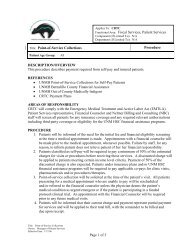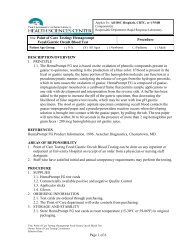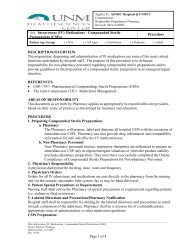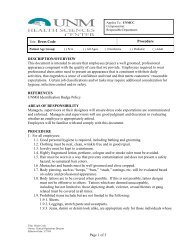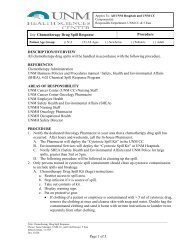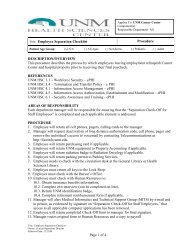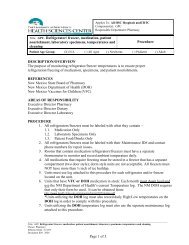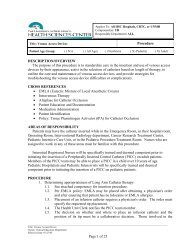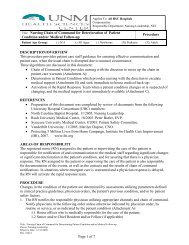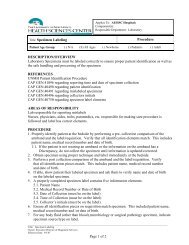(moderate) sedation in accordance with the following procedure.
(moderate) sedation in accordance with the following procedure.
(moderate) sedation in accordance with the following procedure.
Create successful ePaper yourself
Turn your PDF publications into a flip-book with our unique Google optimized e-Paper software.
2.3 Have reversal agents immediately available.<br />
2.4 Consent = Time-out requirement<br />
-Correct patient<br />
-Correct Side & Site<br />
-Agreement on Procedure be<strong>in</strong>g performed<br />
-Correct patient position<br />
-Availability of correct implants, equipment, labs and x-rays.<br />
-Entire team present.<br />
3. Implementation<br />
3.1 Monitor<strong>in</strong>g will be done by personnel that have demonstrated <strong>moderate</strong>/conscious<br />
<strong>sedation</strong> competency. The <strong>in</strong>dividual monitor<strong>in</strong>g shall NOT have additional duties or<br />
responsibilities.<br />
3.1.1. Neurological<br />
3.1.1.1. Level of consciousness (LOC) should be assessed every 1 to 2<br />
m<strong>in</strong>utes dur<strong>in</strong>g <strong>the</strong> onset of <strong>sedation</strong> and whenever medications are<br />
be<strong>in</strong>g titrated.<br />
3.1.1.2. Assess for oral, thumbs-up or eye open<strong>in</strong>g response to verbal or light<br />
tactile stimulation.<br />
3.1.2. Respiratory<br />
3.1.2.1. Observation of respirations, chest movement, color and auscultation<br />
of breath sounds<br />
3.1.2.2. Cont<strong>in</strong>uous pulse oximetry<br />
3.1.2.3. Supplemental oxygen should be adm<strong>in</strong>istered as needed<br />
3.1.3 Cardiovascular<br />
3.1.3.1 Monitor heart rate and blood pressure every 1-2 m<strong>in</strong>utes dur<strong>in</strong>g onset<br />
of <strong>sedation</strong>.<br />
3.1.3.2 Monitor heart rate and blood pressure every 5 m<strong>in</strong>utes dur<strong>in</strong>g<br />
<strong>procedure</strong>.<br />
3.1.3.3 Cont<strong>in</strong>uous ECG monitor<strong>in</strong>g for patients <strong>with</strong> underly<strong>in</strong>g<br />
cardiovascular disease, <strong>procedure</strong>s <strong>with</strong> an <strong>in</strong>creased risk of<br />
dysrhythmia or patients who have a detected dysrhythmia per<br />
auscultation. This shall <strong>in</strong>clude all patients <strong>with</strong> ASA score 3 or<br />
greater. Crash carts serv<strong>in</strong>g multi-patient areas will not be used for<br />
elective <strong>procedure</strong>s. Moderate/Conscious Sedation carts will be<br />
used.<br />
4. Evaluation<br />
4.1 Recovery Care (Medical P&P)<br />
4.1.1 Patients must be monitored by personnel that have demonstrated<br />
<strong>moderate</strong>/conscious <strong>sedation</strong> competency to ensure that any adverse events are<br />
rapidly recognized and appropriately treated. The <strong>in</strong>dividual monitor<strong>in</strong>g<br />
recovery shall NOT have additional duties or responsibilities.<br />
4.1.2 Vital signs should be recorded at 10-15 m<strong>in</strong>ute <strong>in</strong>tervals and as needed until<br />
discharge criteria are met. Pulse oximetry should be cont<strong>in</strong>ued until <strong>the</strong> patient<br />
is no longer at risk for hypoxemia.<br />
4.1.3 If any reversal agents were used, <strong>the</strong> patient must be observed for two hours to<br />
Title: Procedural Sedation - Conscious<br />
Owner: Procedural Sedation Committee<br />
Effective Date: 10/12/06



